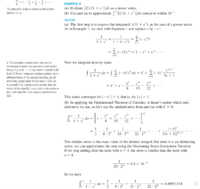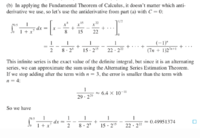Mampac
New member
- Joined
- Nov 20, 2019
- Messages
- 49
Hello,
I managed to find the power series form for the function -- separated x2, rewrote the denominator as 1 - (-2x)3, got a power series with n running from 0 to infinity with the term (-1)n23x3n. I pulled out the 23 as 8 and got 8x2 times the power series.
For the integral, I integrated the power series by term-by-term integration and evaluated from 0 to 1/4.
Now I got some issues in b: my question is, for the remainder |R| <= an + 1 <= 10-2, should I include the 8x2 in my computations?
I proceeded to write that an+1-1 => 100, and plugged in ns, starting from 1, inside the an+1-1.
What to do with 8x2 then? Maybe I shouldn't've pulled it out of the series, or maybe after I find the Sn (it turned out S1 suffices since the condition was met at n = 1) I have to do additional computations?
I mean it seems like I found a value but it looks extremely suspicious.
Thank you in advance!



